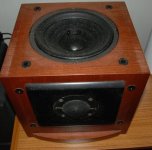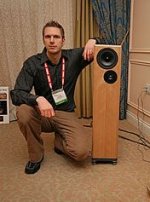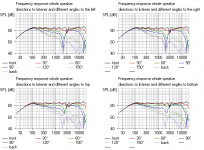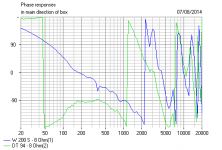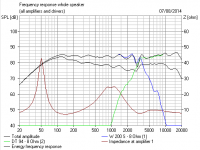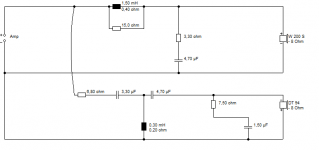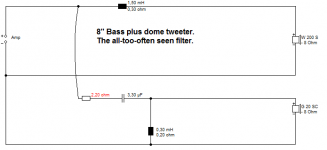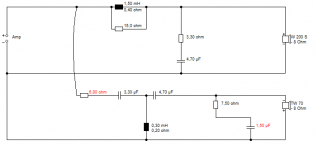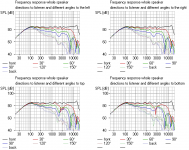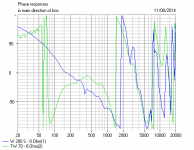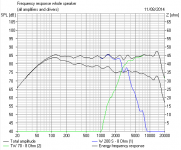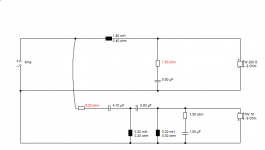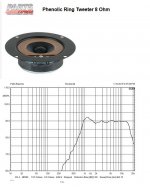No. No. No. Speakers with poor dispersion, and 8" plus tweeter falls into that category, work best in the far-field.Anybody tried 8"+1 as nearfield ? 🙂 [ ~3ft listening distance ]
I am curious to try that...
Also keen to once compare a 8" and 6.5-7" woofer based speakers (using woofer from same family to rule out other differences as much as possible eg U18 and U22) and same tweeter...
Basically to know how much difference does it really make ....
Like the big old 15" Tannoys. Or any sort of MTTM speaker which beams in a different way.
Near field works best with compact speakers for monitoring. 🙂
Also many folks seem to favor 2nd order acoustic xover for its natural sound.
Right. There's a basic fact which often is overlooked or unknown:
The transient response of high-pass filters inevitably deteriorates with increasing filter order.
It's well known that the transient response of a woofer is better in a closed box (2nd order) than in a vented box (4th order). Exactly the same happens to the tweeter with different filters. People who use a digital crossover (DSP) and choose LR8 have no idea what they do in this respect. The same applies to people who call LR2 Mickey Mouse. Troels Gravesen made four different versions of the Discovery 18: 18W-8434G00. He describes the final V3 version:
Making the stepped baffle and implementing a true LR2 filter made a world of a difference. Suddenly music started flowing and sense of depth and perspective improved vastly. I never heard the difference between a flat baffle/2nd-3rd order crossover and a stepped baffle/true LR2 filter so clearly. It's night and day.
Since then Troels Gravesen makes LR2 crossovers with stepped baffle:
ScanSpeak-3W-Discovery
SEAS-3-Way-Classic-mkII
...The same applies to people who call LR2 Mickey Mouse...
That's me you're insulting, right? 😕
LR2 IS strictly Mickey Mouse in the context of flat baffle 8" two ways! It sounds dreadful. 😀
Time aligned is another game altogether. A game I can play if you want. Here I rely on negative polarity at 3kHz to get some phase alignment on flat baffle. A trick well established by KEF and the BBC years ago.
If I wanted to employ LR2 I would cross over at 1kHz with a 4" mid/tweeter. That's OK and quite Siegfried Linkwitz, but it's really compromising the top end above 10kHz more than I like.
We are in the business of building speakers that are practical, and I really don't want to digress into 6" bass, which is a very difficult speaker to get right. Three ways are altogether easier. All clear? 😎
Last edited:
I've been using my old KEF 103.2 as computer speakers for years. 8" + 1" 2-way. Sounds very good to me, but then, I've always liked these. I sit about 1 meter from them, they're about 1 meter apart.
No. No. No. Speakers with poor dispersion, and 8" plus tweeter falls into that category, work best in the far-field.
Near field works best with compact speakers for monitoring. 🙂
I have seen that speakers like Behringer 2031a have constant directivity of +/- 50 deg even upto 15kHz would that be enough ?
For even wider dispersion and an 8" would need to go with 3-way...
I somehow don't like vocals on smaller cones. But yes a proper comparison like mentioned earlier will clear that...
And I thought if many 8+1 can be measured at 1m, then can be heard as well.....
All I can say is that a big powerful monitor is slightly wasted as a computer speaker... 🙂
There are many ways to skin a cat, as they say. The Behringer monitor actually strongly resembles one of Dr. Geddes excellent waveguided designs.
Here's a few other variations on the theme. Time aligned and the remarkable wall mounting Roy Allison speakers. Personally, I find the DeVore inverted speaker most interesting, since it works WITH the downward lobing of what I assume is a BW3 filter to point it upwards.
There are many ways to skin a cat, as they say. The Behringer monitor actually strongly resembles one of Dr. Geddes excellent waveguided designs.
Here's a few other variations on the theme. Time aligned and the remarkable wall mounting Roy Allison speakers. Personally, I find the DeVore inverted speaker most interesting, since it works WITH the downward lobing of what I assume is a BW3 filter to point it upwards.
Attachments
No. No. No. Speakers with poor dispersion, and 8" plus tweeter falls into that category, work best in the far-field.
Like the big old 15" Tannoys. Or any sort of MTTM speaker which beams in a different way.
Near field works best with compact speakers for monitoring. 🙂
Are you saying that 12" or 15" Tannoys have bad dispersion?
Because I struggle to find speakers with better dispersion. Tannoys just narrow to 90deg at crossover and stay at that up to 16k or better.
They are one of the few speakers that work equally well from extreme nearfield all the way out to farfield conditions. It really doesn't matter if you sit 1ft or 10ft away from them.
First speaker I ever built was a 15" Tannoy, Mr. Darwin. Stuck 'em in a big reflex box and turned up the volume and we all retired to a safe distance (about 20 yards) before the music started. Rather good. But you're not suggesting they make good computer speakers, are you? 😀
But this thread is about 8" bass and tweeter. Here's something I don't mind at all:
That's the mylar dome Visaton DT 94 - 8 Ohm. These sort of tweeters had their vogue. KEF and Celestion used them a lot.
Some graphs below. Good dispersion on BW3, I think you'll agree. None of the all too familiar hole of LR4. Nothing wrong with them at all. Very mellow sound. 🙂
But this thread is about 8" bass and tweeter. Here's something I don't mind at all:
An externally hosted image should be here but it was not working when we last tested it.
That's the mylar dome Visaton DT 94 - 8 Ohm. These sort of tweeters had their vogue. KEF and Celestion used them a lot.
Some graphs below. Good dispersion on BW3, I think you'll agree. None of the all too familiar hole of LR4. Nothing wrong with them at all. Very mellow sound. 🙂
Attachments
First speaker I ever built was a 15" Tannoy, Mr. Darwin. Stuck 'em in a big reflex box and turned up the volume and we all retired to a safe distance (about 20 yards) before the music started. Rather good. But you're not suggesting they make good computer speakers, are you? 😀
I'm using a pair of 12s as I type. ;-)
I'm using a pair of 12s as I type. ;-)
In that case 8" ones would be compact monitors for a PC 🙂 🙂
In that case 8" ones would be compact monitors for a PC 🙂 🙂
At 46L they are a bit bulky but they are by far the best computer speakers I've ever heard! ;-)
At 46L they are a bit bulky but they are by far the best computer speakers I've ever heard! ;-)
And nothing whatsoever to do with 8" bass plus 1" tweeter. Just sayin'... 🙄
And nothing whatsoever to do with 8" bass plus 1" tweeter. Just sayin'... 🙄
True but then you are the one who said that big Tannoys only work in the farfield which is patently untrue. Turn them down enough and they'd work as headphones if you could find a way to mount them on a yoke.
I said no such thing. I said big speakers work BEST in the far field. 😛True but then you are the one who said that big Tannoys only work in the farfield which is patently untrue. Turn them down enough and they'd work as headphones if you could find a way to mount them on a yoke.
This is because big apertures produce plane waves in the far field. Which is what you want.
In the near field you want small apertures and get spherical waves. It's one of those results that come out of the spatial fourier transform and antenna theory.
Back on topic, lets look at the "all-too-often seen" schematic for 8" paper bass and how it works:
An externally hosted image should be here but it was not working when we last tested it.
This is really a sort of LR2 arrangement. It has very little going for it, despite being a bit of a staple in HiFi design. Poor power handling and a lot of cone breakup from the bass, which is seeing high source impedance in the midrange if you think about it. I said it can sound good with steeper LR4 slopes, but BW3 is rather good too.
Cheapie £6 Cone tweeter is NOT what people here want to hear, but it does actually sound best. The bass filter is particularly good, keeping some damping and control of the bass voice-coil in the midrange, and will work with ANY well-behaved 8" bass. The third order plus Zobel tweeter filter gives good power handling and a mellow top end. This is what you call a smooth speaker. It may be about as good as it gets. 😎
Attachments
For 8" + 1" on a flat baffle...
There has been discussion on “quasi-optimal” crossovers which use M-T shifted frequencies to cover physical offset M-T distances with modest +/- SPL ripple. The below example provides ~2.1" of M-T offset compensation at 1,400Hz. You can find spreadsheets from LeCleach and others for initial estimates.
3rd order Butterworth Low Pass, -3dB @ Fx*0.87 (+)
3rd order Butterworth High Pass, -3dB @ Fx*1.15 (-)
Offset = 0.22*c/Fx
A variety of quasi-optimal crossovers have been posted for the large midwoofer - horn_tweeter physical offset distances.
There has been discussion on “quasi-optimal” crossovers which use M-T shifted frequencies to cover physical offset M-T distances with modest +/- SPL ripple. The below example provides ~2.1" of M-T offset compensation at 1,400Hz. You can find spreadsheets from LeCleach and others for initial estimates.
3rd order Butterworth Low Pass, -3dB @ Fx*0.87 (+)
3rd order Butterworth High Pass, -3dB @ Fx*1.15 (-)
Offset = 0.22*c/Fx
A variety of quasi-optimal crossovers have been posted for the large midwoofer - horn_tweeter physical offset distances.
Hmm, enough "quasi-science" to impress, but not enough detail to be useful. Admit it, that's just hand-waving really. You don't know. And nor do I. 😀For 8" + 1" on a flat baffle...
There has been discussion on “quasi-optimal” crossovers which use M-T shifted frequencies to cover physical offset M-T distances with modest +/- SPL ripple. The below example provides ~2.1" of M-T offset compensation at 1,400Hz. You can find spreadsheets from LeCleach and others for initial estimates.
3rd order Butterworth Low Pass, -3dB @ Fx*0.87 (+)
3rd order Butterworth High Pass, -3dB @ Fx*1.15 (-)
Offset = 0.22*c/Fx
A variety of quasi-optimal crossovers have been posted for the large midwoofer - horn_tweeter physical offset distances.
What we DO know, is the theory of the LR4 curve is complete. Ideally it is time-aligned and the drivers are both connected positive polarity, whereupon it does whatever it does that makes it so popular. Align your drivers to this curve and you are there:
An externally hosted image should be here but it was not working when we last tested it.
Phase alignment and frequency response is flat. What ISN'T flat is power response above and below axis. Nor is the group delay. That hole may be a feature of this sort of filter, rather than a fault. It's certainly not the only 4th order curve or "Q" you can use, and series crossovers produce a rather different shape or transfer function.
LR4 on a flat baffle relies on negative polarity with 8" bass and regular tweeter, because the acoustic centres mismatch by about 60mm or half a wavelength here unless you bring in a horn tweeter. You get what you get with the modelling and the drivers' natural rolloff.
Below is a fine sounding and detailed speaker which needs good cast bass chassis and a quality bass coil. The drivers play nicely together, and it has that lovely quality that people call "Darkness" between the notes. The ripple in frequency response may be a feature here. It might sound even better time-aligned, but I haven't tried that. 🙂
Attachments
Last edited:
Somebody asked me how the WLM La Scala works via PM. AFAIK it uses the Visaton W200S 4 ohm bass and TW70 cone tweeter. The W200S 4 ohm would sound OK with no bafflestep coil in my estimation, which is what is special about it. 😎
I would emphasize I haven't built this simple series circuit, but have reason to believe it ought to sound rather good despite looking a bit rough and ready. The red 2.7R resistor is the adjustable level control which is an 8 ohm pot in the WLM. I can't think of another good filter that uses the same components.
W 200 S - 4 Ohm
TW 70 - 8 Ohm
Worth trying if you want to have some fun. The bass tuning is discussed at the W200S link. If it's no good, or not to your taste, you could design another filter.
An externally hosted image should be here but it was not working when we last tested it.
I would emphasize I haven't built this simple series circuit, but have reason to believe it ought to sound rather good despite looking a bit rough and ready. The red 2.7R resistor is the adjustable level control which is an 8 ohm pot in the WLM. I can't think of another good filter that uses the same components.
W 200 S - 4 Ohm
TW 70 - 8 Ohm
Worth trying if you want to have some fun. The bass tuning is discussed at the W200S link. If it's no good, or not to your taste, you could design another filter.
Attachments
I thought I'd give you an update on current thinking on the 8" bass plus tweeter issue. I've been having a lively conversation with my diyaudio friend fatmarley in Cheltenham. Matt is neither fat nor stupid. He likes the classic Vifa M21 with a waveguide tweeter crossed over at 2kHz. Below.
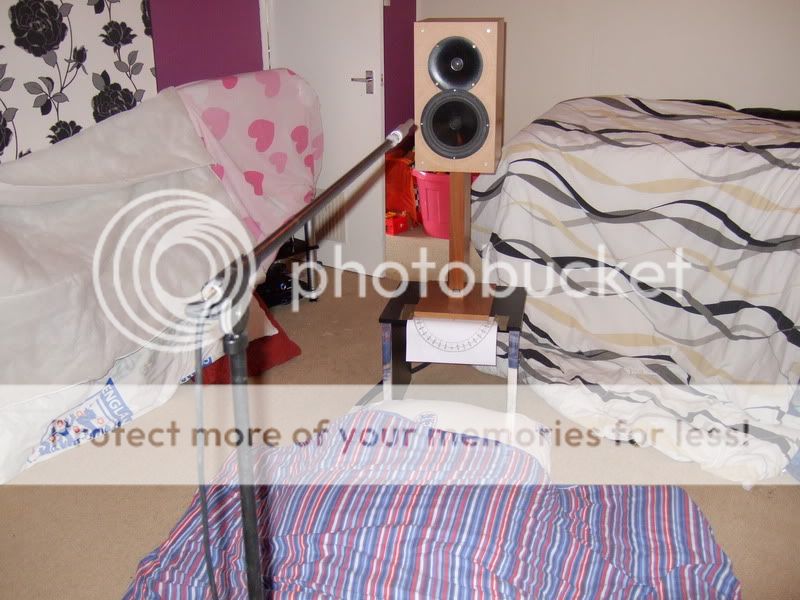
I'd like to hear it. I bet it sounds great. 🙂
I've been investigating BW3 with my own system. But really it doesn't hack it. Not enough overlap between the drivers IMO, much as I like the flat power delivery. Annoying distortion.
So I've reverted to LR4.
The below circuit should work with the Visaton W200S and TW70 drivers. But I've implemented it with another fairly typical Monitor Audio Elac bass and Monacor HT22/8 cone tweeter. I skipped the Zobel with the Monacor since it's a flatter tweeter. I've tried loads of other tweeters, but they just don't have the magic of the cone tweeter.
A very nice speaker, IMO. Very clean sound. The hole in power delivery above and below axis is just what LR4 does. Don't blame me, blame the person who designed this universe. 😀
p.s. I just include the electrical response to give you some insight into why we always talk about it being the overall Acoustic Response that matters overall. The picture of me at my Birthday Party with my niece Holly is just kinda random. 😱

I'd like to hear it. I bet it sounds great. 🙂
I've been investigating BW3 with my own system. But really it doesn't hack it. Not enough overlap between the drivers IMO, much as I like the flat power delivery. Annoying distortion.
So I've reverted to LR4.
An externally hosted image should be here but it was not working when we last tested it.
The below circuit should work with the Visaton W200S and TW70 drivers. But I've implemented it with another fairly typical Monitor Audio Elac bass and Monacor HT22/8 cone tweeter. I skipped the Zobel with the Monacor since it's a flatter tweeter. I've tried loads of other tweeters, but they just don't have the magic of the cone tweeter.
A very nice speaker, IMO. Very clean sound. The hole in power delivery above and below axis is just what LR4 does. Don't blame me, blame the person who designed this universe. 😀
p.s. I just include the electrical response to give you some insight into why we always talk about it being the overall Acoustic Response that matters overall. The picture of me at my Birthday Party with my niece Holly is just kinda random. 😱
Attachments
-
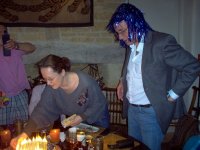 Birthday Candles.jpg87.3 KB · Views: 248
Birthday Candles.jpg87.3 KB · Views: 248 -
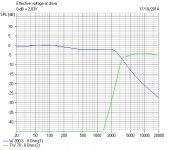 LR4 Electrical Response.JPG63.9 KB · Views: 148
LR4 Electrical Response.JPG63.9 KB · Views: 148 -
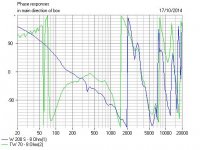 LR4 Phase Response.JPG57.3 KB · Views: 170
LR4 Phase Response.JPG57.3 KB · Views: 170 -
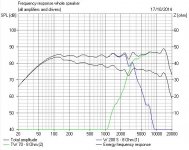 LR4 Frequency Response.JPG62.1 KB · Views: 215
LR4 Frequency Response.JPG62.1 KB · Views: 215 -
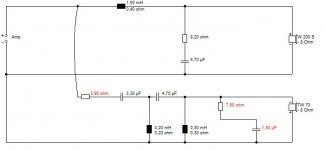 LR4 Circuit.JPG26.3 KB · Views: 212
LR4 Circuit.JPG26.3 KB · Views: 212 -
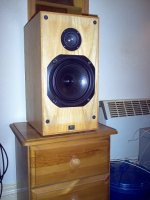 Modified_MA-R300MD_HT22-8.jpg79 KB · Views: 169
Modified_MA-R300MD_HT22-8.jpg79 KB · Views: 169 -
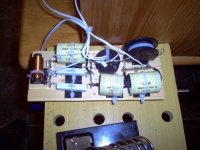 LR4 Crossover.jpg83.1 KB · Views: 261
LR4 Crossover.jpg83.1 KB · Views: 261
Last edited:
I understand. I love 6db crossovers, but...............
I need more volume and enjoy dynamics (I'm used to double 15's crossed @750hz).
So occasionally I hook up this.
Silver flute 8" (4ohm), same mcm round horn waveguide with jbl 2407 compression driver.
Active crossover at 2khz (and cd eq).

But, no bass..........
Qts .23 plus Fs 30hz equals sealed box with F3 around 100hz.
And no baffle step either, but floor/wall loading helps.
Very detail revealing and smooth on the ears.
Excellent mids.
Norman
I need more volume and enjoy dynamics (I'm used to double 15's crossed @750hz).
So occasionally I hook up this.
Silver flute 8" (4ohm), same mcm round horn waveguide with jbl 2407 compression driver.
Active crossover at 2khz (and cd eq).

But, no bass..........
Qts .23 plus Fs 30hz equals sealed box with F3 around 100hz.
And no baffle step either, but floor/wall loading helps.
Very detail revealing and smooth on the ears.
Excellent mids.
Norman
8" plus tweeter is a hard speaker to get right. It's because the bass cone breakup starts around 3kHz, dispersion is not ideal and the time alignment is poor on flat baffle.
Getting the phase aligned seems to have paid off. What I have done exhibits no sibilance whatsoever. The precise bass balance was more exacting than I expected. 1.8mH bass coil made the bass intrude unpleasantly. Surprising that a mere 1dB change of bafflestep makes such a difference.
Using a waveguide tweeter is another school of design that has merit. It's really employing time alignment if you think about it. And gives you more options on crossover point, though perhaps not on slopes.
Future options seem to point in the high efficiency direction. This is light cones and undamped surrounds and inoffensive dustcaps. I have been knocked out by the dynamics of this simple Sony E44 speaker:
You could regard it as not dissimilar in concept to classic old paper EMI 13x8 speakers with a small cone handling the top end.
A single capacitor crossover is just not good enough though. We know how ragged that sounds. FWIW, below is the frequency response of that parts express phenolic ring tweeter. Looks OK. It's hard to find a musical tweeter. Flat frequency response can be deceptive.
Getting the phase aligned seems to have paid off. What I have done exhibits no sibilance whatsoever. The precise bass balance was more exacting than I expected. 1.8mH bass coil made the bass intrude unpleasantly. Surprising that a mere 1dB change of bafflestep makes such a difference.
Using a waveguide tweeter is another school of design that has merit. It's really employing time alignment if you think about it. And gives you more options on crossover point, though perhaps not on slopes.
Future options seem to point in the high efficiency direction. This is light cones and undamped surrounds and inoffensive dustcaps. I have been knocked out by the dynamics of this simple Sony E44 speaker:
An externally hosted image should be here but it was not working when we last tested it.
You could regard it as not dissimilar in concept to classic old paper EMI 13x8 speakers with a small cone handling the top end.
An externally hosted image should be here but it was not working when we last tested it.
A single capacitor crossover is just not good enough though. We know how ragged that sounds. FWIW, below is the frequency response of that parts express phenolic ring tweeter. Looks OK. It's hard to find a musical tweeter. Flat frequency response can be deceptive.
Attachments
- Status
- Not open for further replies.
- Home
- Loudspeakers
- Multi-Way
- 8"+1" two-way DIY speakers

